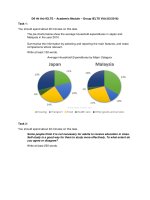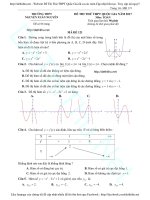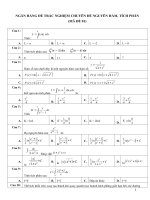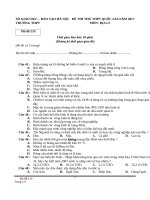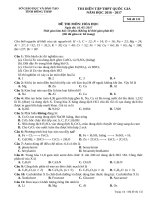ĐỀ THI WRITING IELTS 2017
Bạn đang xem bản rút gọn của tài liệu. Xem và tải ngay bản đầy đủ của tài liệu tại đây (853.57 KB, 13 trang )
by
07/01/2017
Task 1
The chart below shows the average daily minimum and maximum levels of
two air pollutants in four big cities in 2000.
Summarize the information by selecting and reporting the main features, and
make comparisons where relevant.
Band 8.0 Sample Answers:
The provided chart represents the average minimum and maximum amount of
Sulphur Dioxide and Dinitrous Oxide being disposed daily in various cities in 2000.
Overall, Mexico city was the most polluted city with the highest level of both air
pollutants.
As can be seen from the chart, an equal maximum volume of both S02 and N20 of
approximately 200 micrograms per m3 was observed m Mexico City, which doubled
by
the minimum amount of around 80 to 100 micrograms per m3. Los Angeles was
primarily contaminated by N2O, with the minimum and maximum N2O levels being
39 and 104 micrograms per m3 respectively, while the maximum volume of S02
stood at only 10 microgram per m3 .
The second most polluted city was Beijng where a minimum of 25 micrograms per
m3 and a maximum of 130 micrograms per m of S02 was recorded on a daily basis,
whereas the level of N20 ranged from 14 to 54 units. Air quality in Calcutta was
polluted by approximately 47 to 59 microgram per m3 of S02 and 30 to 52
micrograms per m3 of the other air pollutant.
(186 words)
Task 2
Some universities offer online courses as an alternative to classes delivered on
campus. Do you think this is a positive or negative development?
Distance learning is substituting conventional teaching and studying in various
colleges and universities. Even though this trend is deleterious to a certain extent, I
believe that it could be considered positive for some reasons.
On the one hand, e-learning, which does not require regular interaction with
teachers in a classroom setting, can be disadvantageous. Students might fail to
receive a comprehensive development as they often hand in their assignments
online and rarely consult a teacher for improving their weaknesses. This method of
learning can even make some learners procrastinate in their tasks, and as a result
develop a sense of indiscipline and neglect towards the assigned academic work.
By contrast, with the correct guidance and consultation from professional teachers
in the classroom, it would be possible for students to pose questions directly and
fell responsible for their schoolwork.
On the other hand, virtual learning can be a wondrous alternative for students in
their acquisition of knowledge and a degree. The great flexibility offered through
such types of courses means that they can access the lessons and manage their own
pace of learning, which is convenient for adults or businessmen who wish to pursue
higher education. Besides, access to all resources of a traditional course is offered,
by
which empowers learners to have freedom of choice over diverse disciplines. In this
way, knowledge can be spread and education would be available to all, regardless
of backgrounds.
In conclusion, while there are several drawbacks of courses delivered on websites,
studying via the Internet is also a revolutionary mode of learning in contemporary
tertiary education systems.
(262 words)
Distance learning = E-learning = courses delivered on websites = studying
via the Internet >< Virtual learning: học online
Deleterious: có hại = harmful = detrimental to
Require regular interaction: yêu cầu tương tác thường xuyên
A classroom setting: môi trường lớp học
A comprehensive development: sự phát triển toàn diện
Hand in: nộp (bài)
Consult a teacher: tham khảo, hỏi ý kiến giáo viên
Procrastinate: trì hoãn = delay
a sense of indiscipline and neglect: sự thiếu kỷ luật và thờ ơ
pose questions: đặt câu hỏi
wondrous alternative: một lựa chọn tốt
acquisition of knowledge: quá trình tiếp thu tri thức
pace of learning: tốc độ tiếp nhận
pursue higher education: theo đuổi cấp học cao hơn
regardless of = despite = in spite of
mode of learning: phương pháp học tập
tertiary education systems: hệ thống giáo dục bậc Đại học
by
12/01/2017
Task 1
The chart shows the proportion of renewable energy in total energy supply in
4 countries from 1997 to 2010
Band 8 Sample
The given bar chart presents data about the percentages of renewable energy in total
energy production in 4 different countries named Australia, Sweden, Iceland and
Turkey in 3 years: 1997, 2000 and 2010.
Overall, Sweden and Iceland witnessed an upward trend in the use of renewable
energy sources in the three examined years. It can also be seen that among the four
countries, this type of energy was most popular in Iceland.
In 1997, almost half of the total energy produced in Iceland came from renewable
resources. This figure continued to climb steadily to 60% in 2000 and more than
70% in 2010. Meanwhile, in the year 1997, only approximately 5% of the entire
by
amount of energy was generated from natural resources in Sweden,
who experienced a similar trend as that of Iceland in the proportion of renewable
energy.
Regarding Australia, nearly 10% of energy supply was from renewable resources in
1997, and this figure decreased slightly to around 5% in 2010. After minimally
growing to over 40% in 2000, the percentage of this source of energy went down to
about 33% after 10 years.
(185 words)
Task 2
It is neither possible nor useful for a country to provide university places for a
high proportion of young people. To what extent do you agree or disagree?
There has been a difference of opinions regarding the accessibility of tertiary
education to the majority of young people. In my view, dispensing university
educational services on such a large scale brings about no practical values to
society, and also, it is rather unfeasible to carry out this policy.
First, widespread entry into university does not seem really useful to a country since
the government need to take the needs of both the youth and the economy into
consideration. In many countries, especially Germany, vocational training has
gained more popularity among young people because it enhances employment
opportunities as well as job security upon completion. Furthermore, if everyone
could gain admittance to college, it would lead to imbalances in workforce that
would greatly damage economic structure. It is because there is little chance that
university graduates would choose blue-collar jobs such as working in factories.
Second, I think that it is impossible to provide almost all young people with access
to tertiary education. In Vietnam, the demand for entering college never ceases to
grow at a rapid rate. Hence, the government face a dilemma of whether they should
risk allocating their resources and therefore face the possibility of bankruptcy due
to exorbitant education costs in many financially independent universities, like
Foreign Trade University or National Economics University. On top of that, it is
simply unrealistic for universities to accommodate such a suddenly increased
by
number of students on campus, not to mention the fact that most departments are
currently short-staffed.
In conclusion, I strongly oppose the idea of supplying entry to a high proportion of
youngsters owing to the presented arguments above.
(274 words)
Tertiary education: giáo dục bậc Đại học
Dispensing university educational services on such a large scale: Phân phát
dịch vụ giáo dục đại học ở quy mô mới như vậy
Practical values: giá trị thực tế
Be unfeasible to do sth: không khả thi, không hợp lý để làm việc gì đó
Take sth into consideration: xem xét điều gì đó
Enhances employment opportunities: Tăng cơ hội việc làm
Job security: Bảo đảm nghề nghiệp
Imbalances in workforce: Mất cân bằng trong lực lượng lao động
Blue-collar jobs: công việc tay chân, nhận lượng theo giờ
White-collar jobs: công việc công sở
Pink-collar jobs: thị trường lao động phụ, làm bởi phụ nữ
Face a dilemma of: đối diện với sự lựa chọn khó khăn
Exorbitant education costs: Học phí đắt đỏ
Financially independent universities: Đại học tự chủ tài chính
by
14/01/2017
Task 1
The charts show the sources of the electricity produced in 4 countries between
2003 and 2008. Summarise the information by selecting and reporting the main
features, and make comparisons where relevant.
Band 8 Sample:
The given pie charts give information about the proportion of three different sources
that were used to produce electricity in four countries, namely India, Sweden,
Morocco and Vietnam, from the year 2003 to 2008.
Overall, Vietnam and Morocco did not use nuclear power for electricity production.
It can also be seen that while fossil fuel was the largest source of electricity supply
in Vietnam and India, it only occupied a relatively marginal proportion in the other
two countries during the examined years.
by
In Vietnam, 56% of the total amount of electricity was from fossil fuel, and only 5%,
however, was the figure for Morocco. The rest was produced from hydro power in
both nations.
Between 2003 and 2008, fossil fuel contributed 82% to the entire quantity of
electricity in India, which was also the highest among the four countries. Meanwhile,
this source was responsible for the smallest proportion in Sweden, where hydro
power constituted the biggest, at 52%. Nuclear power was used to generate 44% of
the amount of electricity in Sweden while the figure for India was merely 3.5%.
(180 words)
Task 2
In schools and universities, girls tend to choose arts while boys like science.
What are the reasons for this trend and do you think this tendency should be
changed?
It is undeniable that scientific domains of study seem to preferred by schoolboys
whilst schoolgirls are incline to show fancy for ones related to arts. From my
perspectives, several reasons could explain this tendency which should undergo a
change.
There are two main causes responsible for the difference in subject selections
between boys and girls. First and foremost, it derives from natural strengths of each
gender. It is an inescapable fact that various male students are better at rational and
logical thinking in science; hence, they reveal preference for mathematical and
physical realms while the other sex may be more emotional and sensitive to have
advantages in perceiving arts or languages. Equally importantly, the traditional
belief is another contributing factor deciding that divergence. In fact, a number of
parents orientate their girls towards the choice of artistic fields to become elegant
and their sons to pursue science subjects for their future career.
I believe that there is a necessity to change the aforementioned trend. Both male
and female children should be encouraged to find the right balance between arts and
science subjects. Several scientific studies prove that learning arts could boost
children’s creativity and imagination power, enabling them to get insight into
scientific subjects with greater efficiency; meanwhile, majors namely math or
by
physics also generate opportunities for female learners to develop their left brain
and enhance problem-solving competences. Furthermore, as regards numerous
female students who have a flair for math and engineering, forcing them to
specialize in artistic scopes may produce counterproductive outcomes like
resentment and negative attitudes towards their study.
To conclude, that girls prefer arts but boys tend to choose science subjects for
education could be justified for several above-mentioned reasons. Nonetheless, I
argue for a change of this situation.
(292 words)
Domain: lĩnh vực = realm
An inescapable fact: một sự thật không thể chối bỏ
Reveal preference for sth: thích một cái gì đó hơn
A contributing factor: một yếu tố ảnh hưởng
Aforementioned = above- mentioned: đã được đề cập ở trên
Generate/Create/Offer opportunities: tạo cơ hội
Problem-solving competence: Khả năng giải quyết vấn đề
Have a flair for sth: có thiên hướng về cái gì = have/show a talent for sth
Counter-productive outcome/effect/impact: tác động ngược (phản tác
dụng)
by
21/01/2017
Task 1
The charts show the Australian school leavers did immediately after leaving
secondary school. Summarise the information by selecting and reporting the
main features, and make comparisons where relevant.
Band 8 Sample:
The given pie charts give information about what Australian students decided to do
after graduating from secondary school in 1980, 1990, and 2000.
Overall, throughout the years the proportion of this group of Australian students who
were employed was growing, while there was a decline in the portion of those
pursuing higher levels of education.
In 1980, half of Australian secondary school leavers wanted to advance their
scholastic achievements. After a 10-year period, this number plunged to only 38%
and remained nearly unchanged in 2000. Meanwhile, the figure for those who failed
to seek employment in the country was smallest, at only 10% in 1980 and 12% in
1990. It finally experienced a mild decrease to 8% in 2000.
by
On the other hand, Australia saw an increase in the percentage of students who had
a job after graduation from secondary school, from 40% in 1980 to 55% in 2000,
which was the largest among all of the examined categories.
(159 words)
Task 2
Nowadays young people spend too much of their free time in shopping malls.
Some people fear that this may have negative effects on young people and the
society they live in.
The young today spend a large amount of their leisure time in shopping centers. It is
feared that this trend can bring negative influences on the youths and the society. I
strongly agree with this view.
On the individual level, allocating excessive amounts of time on making
purchases at shopping malls can make the young generations waste a great deal of
money. Although browsing for products like clothes or perfumes can be a
captivating experience, the youths are easily tempted into impulsive buying as
there are dozens of brands with various prices and designs for them to choose from.
A clear example is a fashionable girl buying 10 shirts and jeans in a row because
there is a big sale period in progress at Tet Holiday and this costs her somewhere
3 million Vietnam dong, quite a high sum of money. In addition, such items often
end up being unused: some dresses can be left in the wardrobe, covered with dust
and are unfortunately over-sized upon people's first use
On the societal level, the communities can suffer from a decrease in the intellectual
level and work productivity as young people are more interested in leisure pursuits
rather than focusing on their work or study. It is undeniable that an average woman
spends at least two hours doing the shopping while shopaholics can spend a whole
day, and the trend is that they are being more and more willing to spend fewer hours
at the workplace during weekdays, or students often stop reading a book and head
to the nearest shopping mall if their friends ask them out. Gradually, the economy
also suffers due to less work being done, and the youths could slack off in their
by
acquisition of knowledge, making the national education standard drop
significantly.
In conclusion, this trend poses an overall detrimental impact on not only the young
but also the society as a whole.
On the individual level: xét trong phạm vi cá nhân
Allocate time: phân bổ thời gian
An excessive amount of time: một lượng lớn thời gian
Make purchase: mua sắm
Captivating experience: trải nghiệm thú vị
Tempt into doing sth = tempt to do sth: bị lôi kéo làm điều gì đó
Impulsive buying: mua sắm mà không có tính toán
Dozens of brands: hàng loạt nhãn hàng. Dozens of + N
A big sale period: Đợt hạ giá lớn
End up being unused: hóa ra lại không được dung tới
On the societal level: xét trong phạm vi cả xã hội
Lesure pursuits: thú tiêu khiển
Shopaholic: Người nghiện mua sắm
Head to somewhere: đi thẳng đến
Slack off: kém dần, yếu dần, ít dần đi
Acquisition of knowledge: quá trình tiếp thu tri thức
Education standard: tiêu chuẩn giáo dục

